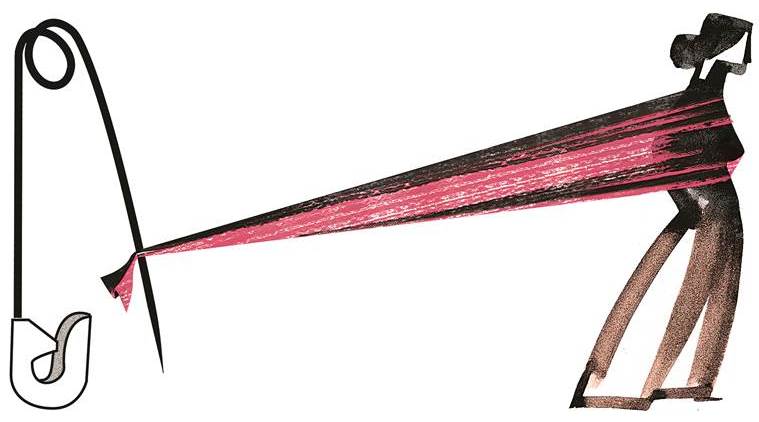On crime against women, bad questions, poor answers
The data in India is flawed, marked by both under- and over-reporting. The question is not whether India’s women are safe, but whether they are free

The debate around the new survey has only proved that India is asking all the wrong questions about sexual crime.(Illustration by C R Sasikumar)
Very rarely does data become a political hot-button issue in India, dominating the shouty nightly news debates and the daily Twitter sniping. Earlier this month, it was about data on the status of women, following an international survey that found India to be the most dangerous country in the world for women.
As a data journalist who has investigated crime and gender, this should have pleased me. But the debate around the new survey has only proved that India is asking all the wrong questions about sexual crime, and still misunderstanding all the answers, six years after it had something of its own #MeToo moment.
Recently, the Thomson Reuters Foundation put out the results of its 2018 The World’s Most Dangerous Countries for Women survey. The Foundation said that it surveyed “548 experts focused on women’s issues including aid and development professionals, academics. and policymakers”. The questions centred on five key areas: Healthcare, economic resources and discrimination, customary practices, sexual violence and harassment, non-sexual violence and human trafficking. India, fourth most dangerous in 2011, was now the world’s most dangerous, it said.
Initial responses to the poll were along predictable political lines, with an Opposition leader sharing it on Twitter and a member of the ruling party accusing him of having “slandered a billion Indians”. But some analysts examined the data and concluded that by international comparison, India cannot be the world’s most dangerous.
In December 2012, a student was gang-raped in a Delhi bus and left to die, an act of such horrific brutality that it became a watershed moment for women’s rights. Young people flooded the streets in protest and the young woman was mourned in marches across the country when she died 13 days later. That December changed the conversation around the place of women in India. Public displays of misogyny and sexism have not abated but public disapproval of it is now far stronger. Discussions around women’s autonomy — to work, to love, in dress — rage on in living rooms, but politicians who equivocate about it are denounced swiftly. Support for victims remains contingent upon other allegiances — religious, for instance — but disgust over this is voiced loudly too.
What has not evolved is India’s use and misunderstanding of data on sexual crime. Much of the debate over the Reuters Foundation data hinged on whether official statistics capture the full extent of sexual crime in India. They do not, but the problem is two-fold: There is the part that official data is not capturing, and the part that it is erroneously capturing.
On the first, it is fair to expect that in a deeply patriarchal and often violent country, women might fear speaking out about sexual crime, and also fear reporting it to the police. The Delhi gang-rape led to months of daily frontpage news coverage for the first time and sexual crime reported to the police spiked in the years after. However, police officials and women rights activists told me that this was a clear result of increased awareness, and better responsiveness on the part of the police, and the spike soon tapered off. Jacob Punnoose, the former police chief of Kerala, a state known to be relatively progressive towards women, understands this relationship well. The state he oversaw routinely reported particularly high violence against women as compared to its poorer, less literate northern counterparts. But to Punnoose, it was clear that this was an indicator of the state’s progress. In this regard, the Thomson Reuters Foundation’s note that crimes against women grew between 2007 and 2016 in India might actually be capturing some progressive rather than regressive trends.
Even so, there is no doubt that there is under-reporting of sexual crime. Comparing official crime statistics of reported sexual assault with what women told household surveyors in the same year, researcher Aashish Gupta showed that less than 1 per cent of sexual violence was reported to the police. But here’s the rub: Nearly all (98 per cent) sexual violence that women told surveyors they had experienced was by their husbands, even while marital rape is not recognised as a crime in India.
Then, there is all that the official data captures that isn’t necessarily about crime. Two years after the Delhi bus rape, I analysed all rape cases decided by Delhi’s local courts in a calender year — nearly 600 in all. I found that the largest share of these were cases involving consensual sex between sometimes inter-religious or inter-caste couples, matches set by the couples themselves often to their families’ disapproval. In case after case, adult couples had been detained by a cooperative, often paternalistic police force, after the woman’s father or uncle filed rape charges against her lover or chosen husband. The women were detained in “shelter homes” and the men tossed into jail as they waited years for their case to be heard. In a majority of such cases, the judges acquitted the men, often after the impassioned testimony of the wife. I found similar trends in Mumbai and rural Madhya Pradesh. This — and the enduring issue of some men being charged with rape after a “breach of promise to marry”, yet another example of the price on a woman’s “chastity” — have had the opposite effect of under-reporting; it inflated the number of rape cases to an unspecifiable extent.
None of this adds up to a particularly positive image. If there is some “over-reporting” of rape in India, it stems from the deep discomfort the country continues to have over women’s sexual autonomy. But the question to ask is not whether India’s women are safe. It is whether India’s women are free.
The writer is a freelance journalist based in Chennai
For all the latest Opinion News, download Indian Express App







































No hay comentarios:
Publicar un comentario